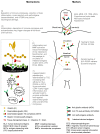Celiac Disease and Neurological Manifestations: From Gluten to Neuroinflammation
- PMID: 36555205
- PMCID: PMC9779232
- DOI: 10.3390/ijms232415564
Celiac Disease and Neurological Manifestations: From Gluten to Neuroinflammation
Abstract
Celiac disease (CD) is a complex multi-organ disease with a high prevalence of extra-intestinal involvement, including neurological and psychiatric manifestations, such as cerebellar ataxia, peripheral neuropathy, epilepsy, headache, cognitive impairment, and depression. However, the mechanisms behind the neurological involvement in CD remain controversial. Recent evidence shows these can be related to gluten-mediated pathogenesis, including antibody cross-reaction, deposition of immune-complex, direct neurotoxicity, and in severe cases, vitamins or nutrients deficiency. Here, we have summarized new evidence related to gut microbiota and the so-called "gut-liver-brain axis" involved in CD-related neurological manifestations. Additionally, there has yet to be an agreement on whether serological or neurophysiological findings can effectively early diagnose and properly monitor CD-associated neurological involvement; notably, most of them can revert to normal with a rigorous gluten-free diet. Moving from a molecular level to a symptom-based approach, clinical, serological, and neurophysiology data might help to disentangle the many-faceted interactions between the gut and brain in CD. Eventually, the identification of multimodal biomarkers might help diagnose, monitor, and improve the quality of life of patients with "neuroCD".
Keywords: celiac disease; gluten ataxia; gut microbiota; transcranial doppler sonography; transcranial magnetic stimulation; transglutaminase.
Conflict of interest statement
The authors declare no conflict of interest.
Figures

References
Publication types
MeSH terms
Substances
LinkOut - more resources
Full Text Sources
Medical

